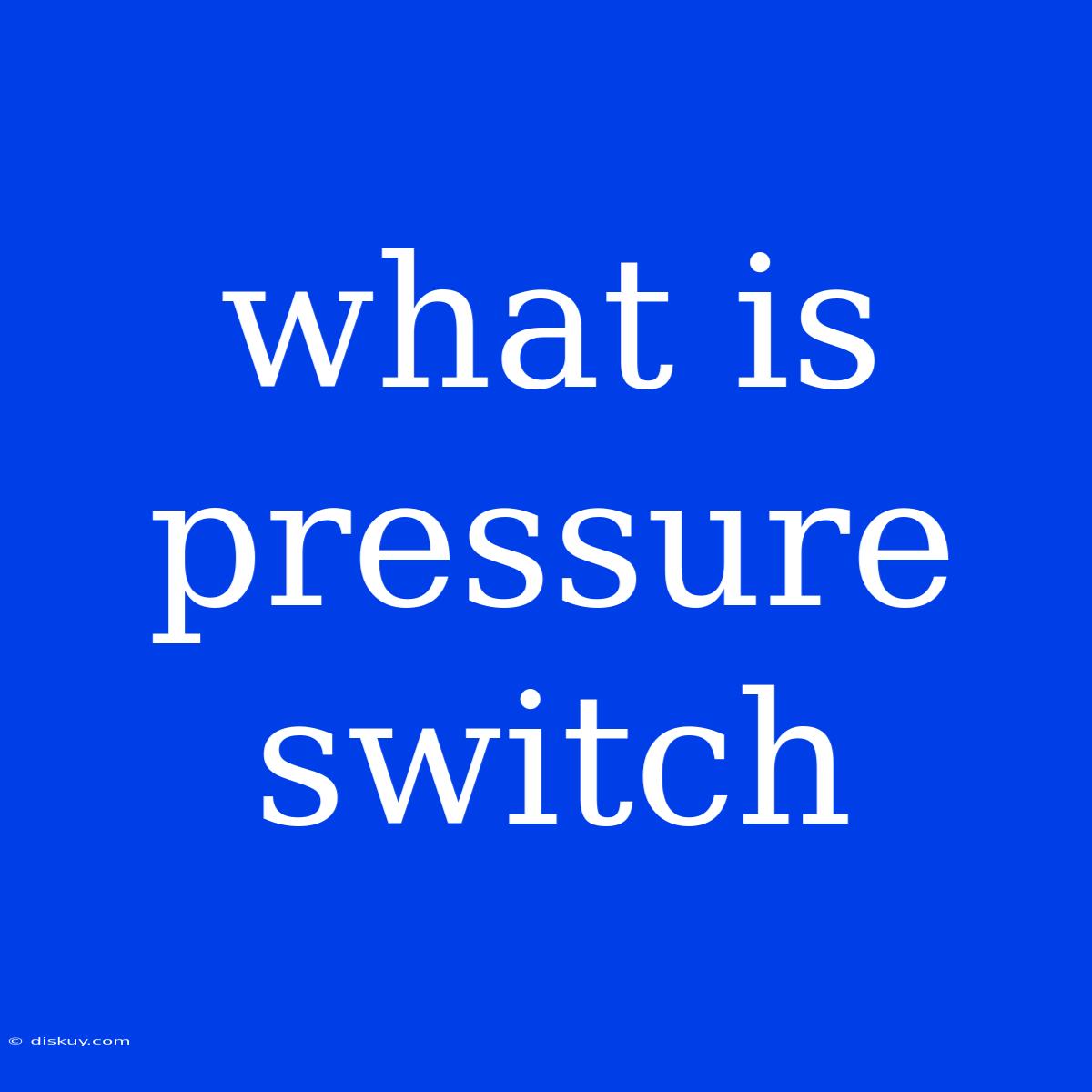What is a Pressure Switch: Unveiling the Silent Guardian of Your Systems
What is a pressure switch, and why should you care? A pressure switch is a safety device that monitors pressure within a system and triggers an action when the pressure reaches a predefined threshold. It's like a silent guardian, working diligently behind the scenes to ensure your systems operate smoothly and safely.
Editor Note: Pressure switches are ubiquitous in various applications, from home appliances to industrial machinery. Understanding their function and applications can be vital for maintaining safe and efficient operations.
Why is this topic important? Pressure switches are crucial components for safety and efficiency. They prevent system over-pressurization, which can cause damage and even accidents. Furthermore, they help optimize system performance by regulating pressure and ensuring efficient operation.
Analysis: This guide delves into the intricacies of pressure switches, exploring their working mechanisms, applications, types, and key considerations. We aim to provide a comprehensive overview that empowers you to make informed decisions regarding these essential devices.
Key aspects of pressure switch:
| Aspect | Description |
|---|---|
| Function | Monitors pressure within a system and triggers an action when a predefined threshold is reached. |
| Applications | Found in various systems like water pumps, HVAC units, compressors, and industrial processes. |
| Types | Differ in pressure ranges, switching mechanisms, and applications. |
| Calibration | Crucial for accurate and reliable operation. |
| Maintenance | Regular checks and cleaning ensure optimal performance and extended lifespan. |
Pressure Switch
Understanding the Basics
Introduction: A pressure switch is essentially a pressure-sensitive device that activates or deactivates a circuit based on pressure variations within a system.
Key Aspects:
- Pressure sensing element: This element, often a diaphragm or a bellows, reacts to pressure changes.
- Switch mechanism: A simple mechanical switch or an electronic sensor converts the pressure signal into an electrical signal.
- Setpoint adjustment: Allows users to fine-tune the pressure threshold at which the switch activates.
Discussion: The pressure sensing element deforms when pressure changes, triggering the switch mechanism. This, in turn, opens or closes the circuit, activating or deactivating the associated equipment.
Delving Deeper: Exploring the Types
Introduction: Pressure switches are available in various types, each tailored for specific applications and pressure ranges.
Facets:
- Differential Pressure Switches: These measure the pressure difference between two points in a system.
- High-Pressure Switches: Triggered when pressure exceeds a predefined high-pressure limit.
- Low-Pressure Switches: Activate when the pressure falls below a designated low-pressure limit.
- Vacuum Switches: Designed to operate in vacuum environments.
Summary: The choice of a pressure switch hinges on the specific system requirements, pressure range, and desired operating characteristics.
The Importance of Calibration and Maintenance
Introduction: Calibration and regular maintenance are crucial for ensuring accurate and reliable pressure switch operation.
Further Analysis:
- Calibration: Periodic calibration using specialized equipment ensures that the switch operates within the correct pressure range.
- Maintenance: Cleaning the sensing element and inspecting the switch mechanism for wear and tear can prevent malfunctions and extend the switch's lifespan.
Closing: Proper calibration and maintenance not only ensure the switch's accuracy and reliability but also contribute to the overall safety and efficiency of the system.
FAQs About Pressure Switches
Introduction: Here are some common questions about pressure switches:
Questions:
- What are the common applications of pressure switches? Pressure switches are used in a wide array of applications, including water pumps, HVAC systems, compressors, industrial machinery, and safety devices.
- How do I select the right pressure switch for my application? Consider the pressure range, switching mechanism, type of system, and safety requirements.
- What are the signs of a faulty pressure switch? A faulty pressure switch might exhibit erratic operation, failure to activate or deactivate, or incorrect pressure readings.
- Can I adjust the pressure setpoint of a pressure switch myself? Adjusting the setpoint should be done by a qualified technician to prevent damage or safety hazards.
- How often should I calibrate my pressure switch? The frequency of calibration depends on the application, usage, and manufacturer recommendations.
- What are the potential risks associated with a malfunctioning pressure switch? A malfunctioning switch could lead to system over-pressurization, damage to equipment, and potential safety hazards.
Summary: Pressure switches are integral safety components that require regular maintenance and calibration for reliable and safe operation.
Tips for Using Pressure Switches
Introduction: Here are some essential tips for utilizing pressure switches effectively:
Tips:
- Choose the right type of pressure switch: Select a switch that meets the specific pressure range, switching mechanism, and application requirements.
- Proper installation: Install the pressure switch according to the manufacturer's instructions to ensure accurate and reliable operation.
- Regular calibration: Calibrate the pressure switch periodically to maintain accuracy and avoid malfunctions.
- Perform routine maintenance: Clean the sensing element and inspect the switch mechanism for wear and tear to ensure optimal performance.
- Monitor switch performance: Pay attention to any signs of malfunction or incorrect readings and address them promptly.
Summary: By following these tips, you can maximize the performance and lifespan of your pressure switches while ensuring the safety and efficiency of your systems.
Summary of Pressure Switches
Overview: Pressure switches play a vital role in maintaining the safe and efficient operation of various systems. They operate by monitoring pressure levels, triggering actions when predefined thresholds are reached.
Closing Message: Understanding the nuances of pressure switches empowers you to make informed decisions regarding their selection, installation, and maintenance, ensuring the safe and reliable operation of your systems. Regular calibration and maintenance are crucial for ensuring accurate and reliable operation, contributing to the overall safety and efficiency of your applications.

